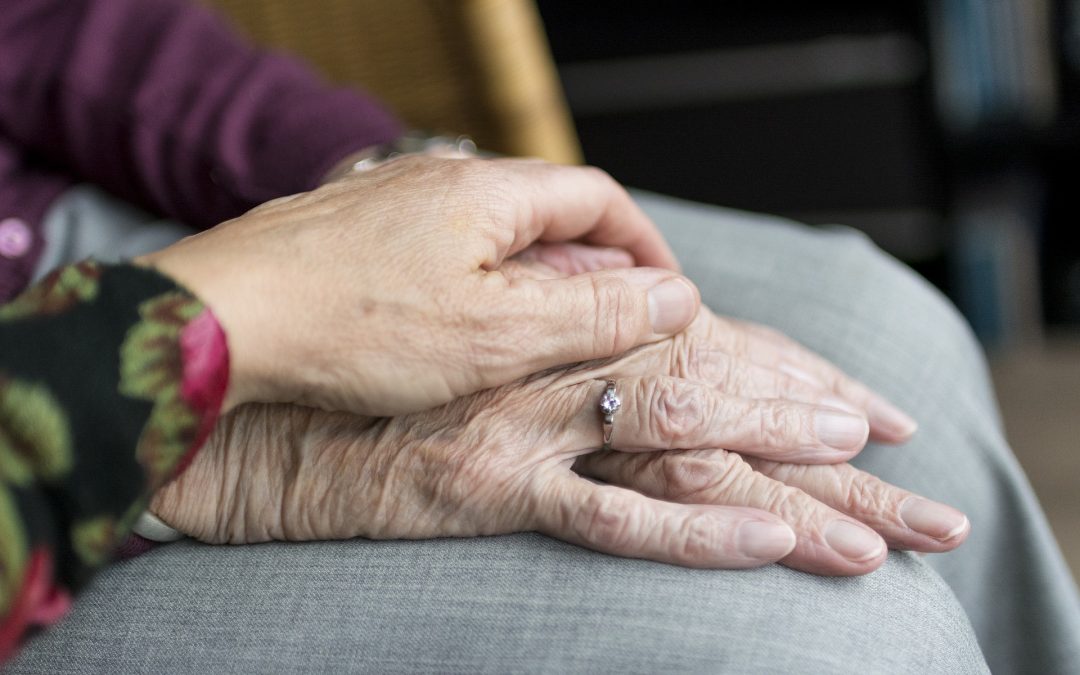I am honored and incredibly humbled to present you this guest blog post from Madeleine Kerkhof, well known for utilizing aromatics in hospice care and palliative care. This is such important work, to enhance the wellbeing of the elderly, and to bring peace and comfort to the ill and dying utilizing aromatics.
© Madeleine Kerkhof-Wellhüner
In my over 20 years of working with natural medicine and aromatherapy, I have seen and experienced the power of aromatic plants and their extracts to the fullest. Apart from conventional essential oils and aromatics, I work with CO2 extracts, still a fairly new thing in aromatherapy. These extracts can be very valuable, I found. In the course of the last 10 years, I developed the course program Fusion AromaTherapy™ in which I teach how to use essential oils and CO2 extracts to enhance the wellbeing of the elderly, the very ill and dying.
As a former nurse, now aromatherapist and expert and teacher complementary therapies, I am accredited by the Dutch Board of Nursing. I frequently visit hospices and palliative care units in The Netherlands, either to teach staff, and in special cases also for consultations. I would like to share with you the profound effect that the use of a blend with a CO2 extract had on patients.
The sleepless couple
I was in the Hospice Laurens Cadenza in Rotterdam, the largest hospice in The Netherlands with 20 beds. Although it is a modern building and the biggest in The Netherlands, there is a good and homely atmosphere.
That day I was there to teach nurses and volunteers. They had been taught basic complementary care techniques by me, including aromatherapy – which we prefer to call AromaCare – in the months before and were about to have an in depth one day seminar about complementary care on the subject of anxiety, depression and sleeplessness.
I usually arrived at the hospice some time before any seminar would start so I could answer any questions the staff might have. The head nurse told me about an elderly couple, let’s call them Mr. and Mrs. Janssen.
Mrs. Janssen was admitted a couple of weeks earlier, suffering from bowel cancer. Her life expectancy at the time of my visit was approximately one week. Mrs. Janssen also suffered from dementia, which left her confused and unable to express her fears, pains and worries. Although the staff tried everything to make her feel as comfortable as possible, she remained restless and disorientated.
They were both in their late 80’s and spent day and night together. They had been married for over 50 years and it was very difficult for Mr. Janssen to let her go. He hardly left the room, afraid that his wife would pass when he wasn’t around, or that she would become even more unsettled when she sensed his absence. He was very distraught about his wife’s progressing disease and imminent passing. It was extremely hard for him to see her deteriorate in this way. After all the years they had been together, he could not face living without her.
The nights were difficult for both of them. Mrs. Janssen was very restless and hardly slept at all. As a consequence, Mr. Janssen did not get any sleep either.
The head nurse and I decided to choose a blend of essential oils to diffuse in the room to make the couple more comfortable. Red mandarin (Citrus reticulata) was chosen for its positive effect on anxiety and sleeplessness and for its friendly sunny smell that brings sunshine in your heart and which would also appeal to Mrs. Janssen’s inner child.
Lavender High Altitude from the Haute Provence (Lavandula angustifolia) was chosen, because the couple both loved lavender. This special type contains high amounts of linalyl acetate and linalool, being one of the most calming en soothing lavenders of all.
Furthermore I chose frankincense CO2 extract for its unique scent and it’s relatively high contents of incensole acetate. Carefully CO2 extracted from Boswellia carterii resin from Somalia, it is the best extract of frankincense if you ask me. It is said that frankincense helps you to look beyond earthly matters and to let go of grief and old pains without having to go through all the motions again, something that this couple was not able to do anymore.
Frankincense is also one of the oils that can bring a deep sense of calm and rest, especially to confused and restless patients. It also helps to deepen en calm patients breathing patterns, contributing even stronger to the sedative effect.
Mr. Janssen was quite overwhelmed that we thought of such a personal blend. But not only that. He reminisced with tears in his eyes that his wife had loved the scent of frankincense from going to church. This particular pure frankincense extract came very close to the memory about treasured rituals during service in their local chapel.
Mr. Janssen simply loved the combination of the three oils. His wife could not respond verbally when we offered her the blend but she showed in no uncertain ways how it made her feel. To make a long story short, this lovely couple found a deep sense of peace and slept like babies during the last three days of Mrs. Janssen’s life.
What impressed me the most, and I will never forget that, was that we not offered peace and serenity to both Mr. and Mrs. Janssen, but more so that we managed to positively influence Mr. Janssen’s memory of his wife’s passing. Mr. Janssen was deeply thankful that his wife was able to come to rest and die in peace. That made the hardest thing he ever had to do just a little bit easier: letting go and retaining only the best memories of his beloved wife until the time came for him to join her.
Super Critical CO2 extraction in short
What is so special about CO2 extracts?
CO2 extracts, also known as supercritical CO2 extracts, are extremely pure plant extracts that are very similar to the original plant material. CO2 extracts are increasingly used in the flavoring and herbal medicine industries, as well as in perfumery and aromatherapy. Using CO2 extracts in aromatherapy requires specific knowledge of medicinal plants, their active components and the way they influence body, mind and spirit. Sometimes the extracts contain substances that were previously unknown in aromatherapy, simply because the extraction method was not available in aromatherapy when most books were written. The first (to my knowledge) who wrote about CO2 extracts – ginger – was Eliane Zimmerman, who inspired me greatly with her book for health professionals. In The Netherlands I was the first one to use CO2 extracts on a large and professional scale in aromatherapy, and worldwide I was the first to write a book on them: CO2 Extracts in Aromatherapy, 50+ Extracts for Clinical Applications, which was published in April of this year.
A brief explanation
Essential oils have traditionally been derived by steam or hydro distillation, expressed from the rinds of citrus fruit, or extracted using chemical solvents such as hexane, toluene or ethanol.
CO2 extraction uses pressurized carbon dioxide that is pumped into a vessel filled with plant matter. When carbon dioxide is subjected to a pressure of 73 bar and reaches 31°C, it becomes “supercritical” and starts behaving like a solvent, extracting essential oils and other CO2 soluble substances such as pigments, fatty acids, waxes and resins from the plant material.
CO2 extraction is a highly selective process. By altering the pressure and / or temperature, more or less substances are extracted. The temperature involved in the supercritical extraction process can vary between -10°C to around 65°C. CO2 extracts therefore are not subjected to thermodegradation. Nor are there changes due to oxygenation, because the process is performed under exclusion of oxygen.
By lifting the pressure after extraction, the carbon dioxide will turn into gas again and the extract remains, with no residue of the CO2 whatsoever and ensures that the plant molecules remain unchanged.
CO2 select and CO2 total
There are two main kinds of CO2 extracts:
CO2 select. The result of this method can be compared to steam or hydro distillation. A lower pressure is used to extract mainly volatile CO2 soluble components. This results in an oil that is similar, but often richer in composition and superior in fragrance to distilled essential oil.
CO2 totals. Here, a higher pressure is used. This extract will contain all CO2 soluble components, such as waxes, resins, pigments, fatty acids, essential oil, etc. In these extracts we often see molecules that will not show up in the essential oil of the same plant material. Ginger CO2-total for instance contains the valuable molecules gingerol and shogaol – well founded for their action against nausea and pain – that are not found in distilled ginger oil or in its CO2-select extract. Totals are almost identical to the plant they are derived from. They in turn are soluble in essential oils or in vegetable plant oils. Some need gentle warming to approximately 30°C to become fluid before adding them to any base product.
Pure plant
The scent of these extracts is as pure as the plant material itself. There is an almost unlimited potential to use CO2 extracts in psycho-aromatherapy.
In The Netherlands, especially in end of life care, guided imagery is utilized as a pleasant complementary technique that helps patients to unwind and to “go places” that bring fond memories or a sense of peace. Smelling the scent of German chamomile CO2 extract brings you to a chamomile field instantly, and the extract of lavender immediately brings memories of Provence, or the lavender in your grandmother’s garden. Many patients, especially those with cognitive issues respond extremely well to the purest scents of cinnamon bark Burmanii, star anise, vanilla or frankincense.
Pure medicine
CO2 extracts are pure, stable and completely free of chemical solvents such as hexane, pesticides or other unwanted substances. Production is environmentally friendly and very safe. There are many certified organic extracts available nowadays.
The medicinal properties are extensive and sometimes I’m blown away by the results. Generally speaking many CO2 extracts are richer and more intense, because a more complete profile of the plant is present in the end product.
Even small percentages (0.5-1%) can be extremely effective as additions to massage oil, creams, ointments or essential oil blends. It is vital however that indications, contra-indications, possible side effects and interactions with medication or other substances are carefully considered, just like we would do with conventional essential oils and aromatics. Once you have gained enough knowledge about the different components and their possible uses and limitations in medicine, you will find that they can give great results and be cost-effective at the same time.
Example: marigold
A very good example is marigold (Calendula officinalis). In my garden I grow marigolds for maceration. I macerate the flowers in a variety of base oils for different purposes. In almost all the skin care products I prepare on request for use in health care facilities I use marigold macerate.
Since I discovered how extremely valuable the CO2-total extract of marigold is, I add a certain percentage to many special formulations for the care of wounds, burns, abrasions and mouth care gels. We know that marigold flowers are rich in faradiol esters. The higher the percentage of faradiol esters, the better the anti-inflammatory properties, especially on the skin. The marigold CO2–total extract can contains around 25-28% faradiol esters, as well as carotenes and over 3% of essential oil.
Different
CO2 extracts can be quite different from essential oils. So can they be used in the same manner as essential oils? Sometimes they can, sometimes they cannot. To shed light on that I describe over 50 extracts in my new book, which is now available around the world. I feel there is great potential in the use of CO2 extracts in modern aromatherapy, and the results I book on patient wellbeing are excellent. And that is my main passion: fusing aromatics together in blends and treatment options to enhance health, wellbeing and quality of life.
If you have any questions, you can find me through info@kicozo.nl.
Kind regards,
Madeleine Kerkhof.
References:
Please see for extensive lists: CO2 Extracts in Aromatherapy, 50+ Extracts for Clinical Applications, M. Kerkhof, 2016, Kicozo.
Madeleines’ books found here
Links to upcoming courses in the USA
http://www.kicozo.nl/course-3-days-in-usa-fusion-aromatherapy-in-palliative-care/
http://www.kicozo.nl/course-4-days-in-usa-fusion-aromatherapy-and-pain/




